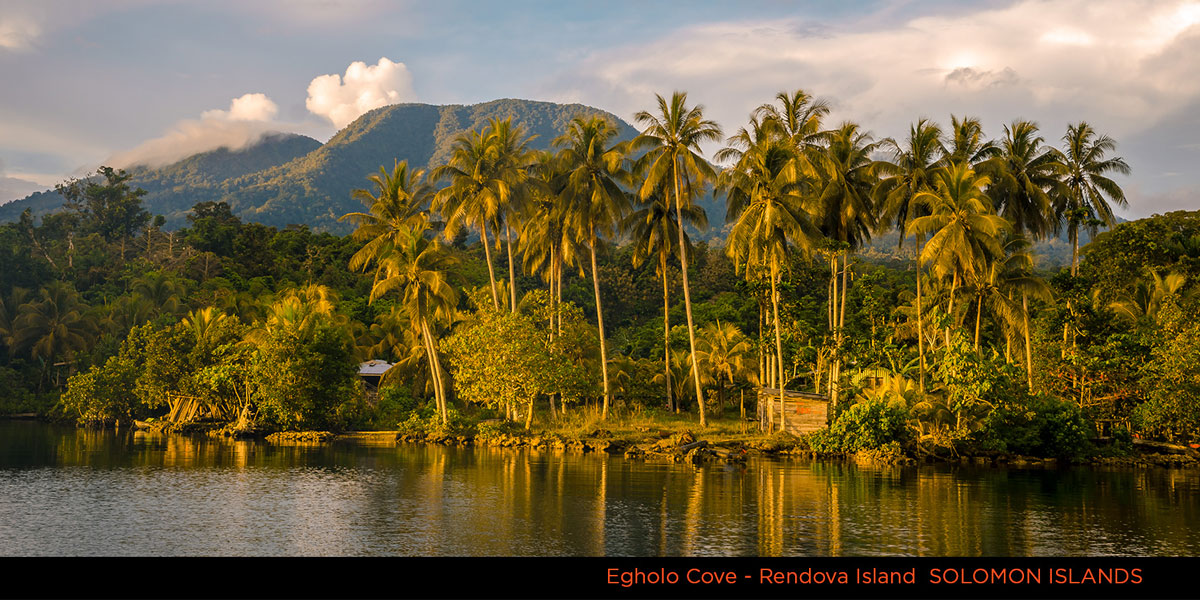We didn’t know what to expect in the Solomon Islands except for World War II relics from the Battle of Guadalcanal.

Upon arriving, we realized this country is made up of several islands with small villages. The locals use dugout canoes as their primary mode of transportation.

In our time there, we mingled with locals who are dark-skinned, but not of African descent.

An interesting trait of Solomon Islanders is they have a broad spectrum of hair colors.
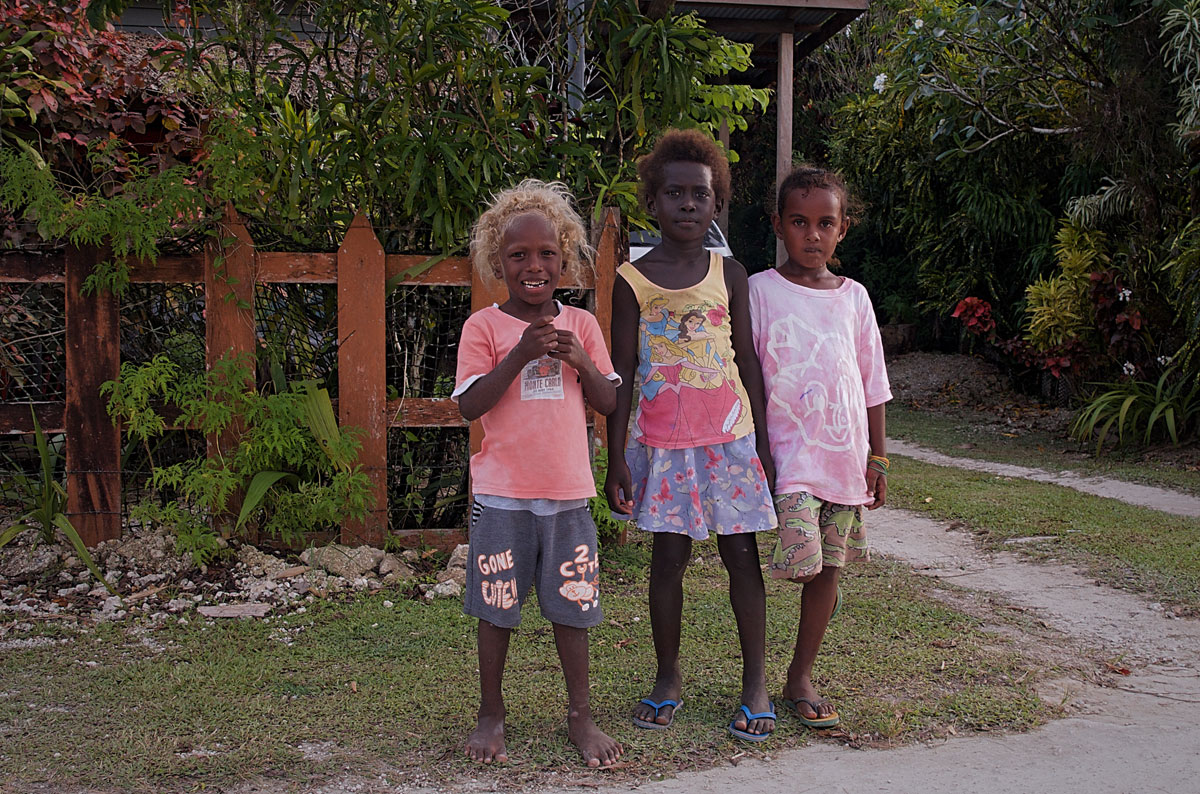
We were fascinated that Solomon Islanders and other Melanesians are the only people besides Europeans with blond hair.

Each day in the Solomon Islands was an eye-opener, as we learned about this tiny corner of the world with its captivating culture.
Why Travel to the Solomon Islands?
In September and October 2019, my wife Khadija and I spent a wonderful week in the Solomon Islands. There are many World War II relics, slowly decaying in the forest and underwater.

It’s a haven for divers (especially for shipwrecks), snorkelers (the coral is generally in good shape and not bleached), and anglers (fishing in deep seas, outer reefs, and lagoons). There are many small villages to explore, as the Solomon Islands have only one large city (capital Honiara) and few towns
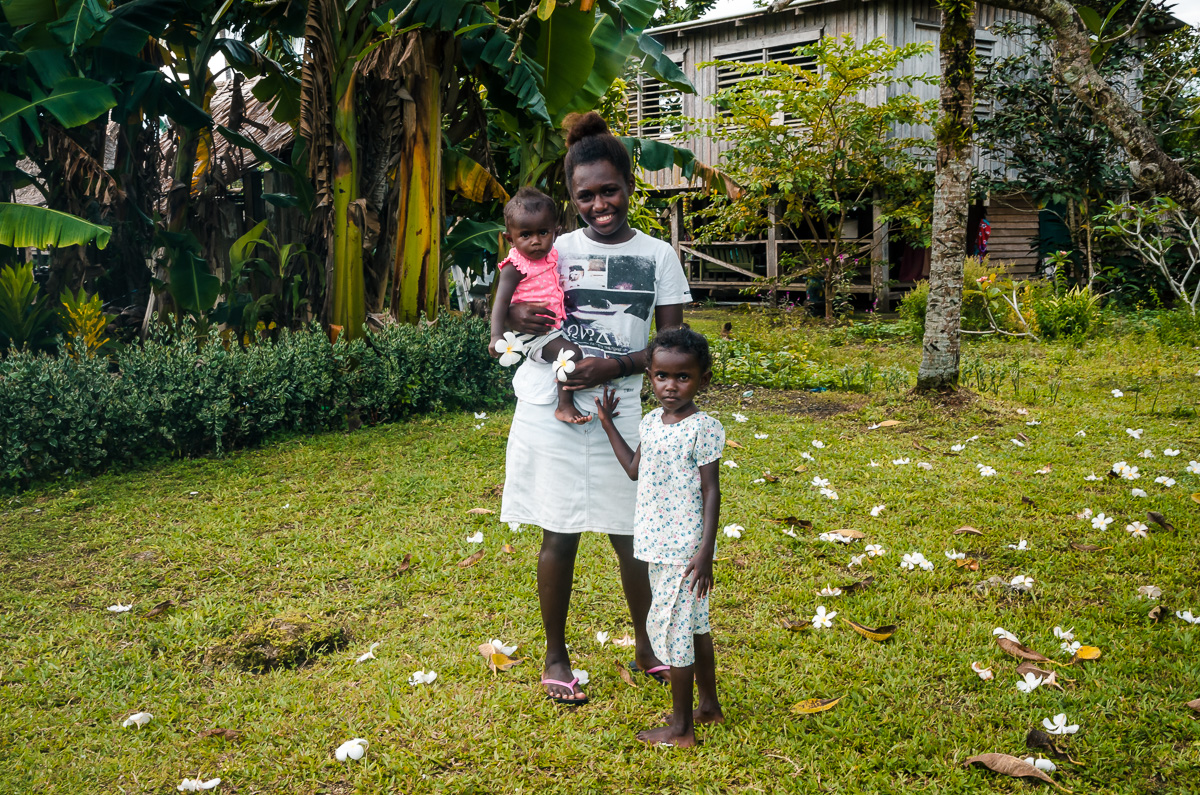
However, the Solomon Islands is one of the least visited countries in the world. According to the Solomon Island National Statistics Office, since 2010, the country only had between 20,000 and 25,000 annual visitors, about half from Australia. Only about 30% were tourists, the rest came for business, to visit relatives and friends or were in-transit.
Why do so few people go to this terrific place?
First, there is so little information on the country. We could not even find a current travel guide and had to rely on an out-of-print Lonely Planet guide published in 1997. It has an enormous amount of information, especially maps, not available on-line.
Second, there are hardly any roads and virtually no public transportation outside of Honiara and a few towns. Thus local boats are the only way to get around.
Third, the government does not actively promote tourism (unlike neighboring Vanuatu). Instead, it’s focused on leasing land to the forestry and fishing industry.
Fourth, there was ethnic violence from 1999 to 2003 between the islands of Guadalcanal and Malaita, which led to the breakdown of government services. Given this situation, most tourism stopped. The country has not seen a significant revival in tourism since then.
While many may not want to make an effort or have the interest to go there, it’s one of the few places in the world to see traditional villages with few visitors and untouched nature.
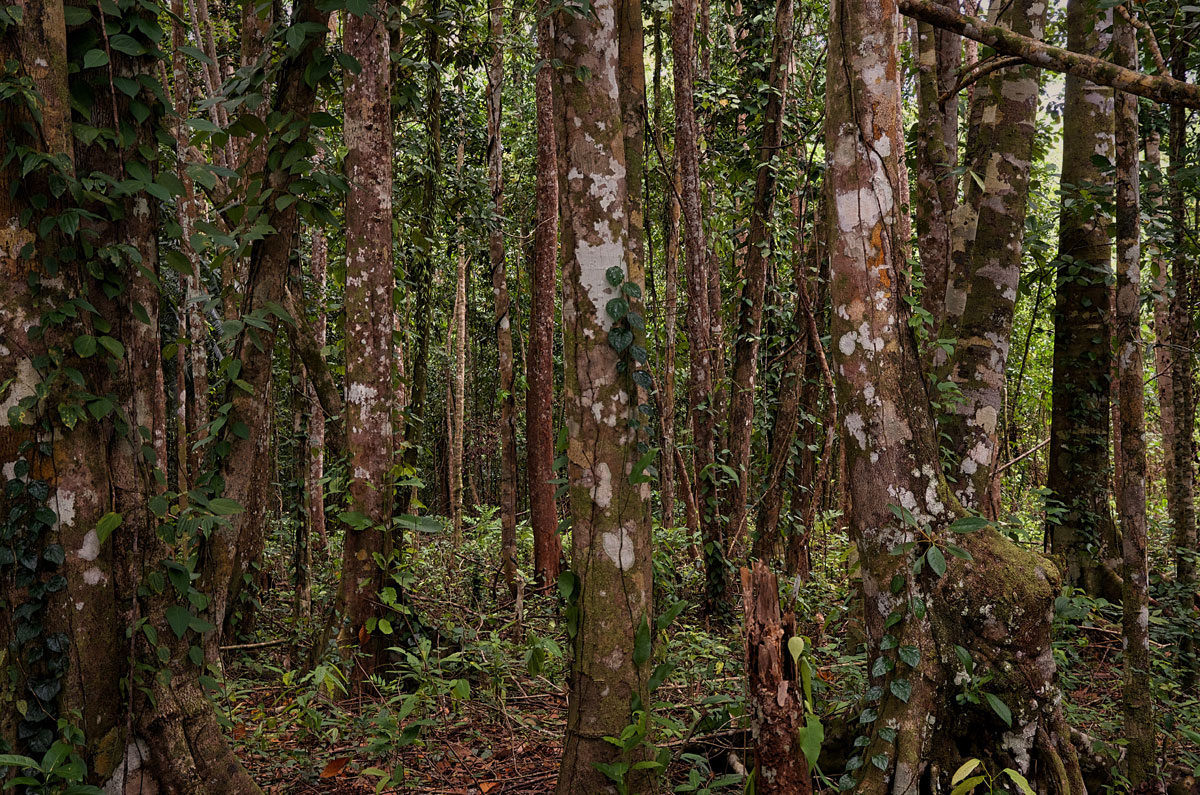
The islands are laid-back and have few big resorts. Instead, you can stay in family-run lodges and explore with local guides.
Where are the Solomon Islands and How Did We Get There?
The Solomon Islands are part of Melanesia, which includes Vanuatu, New Caledonia, Fiji, and New Guinea Island. Melanesia is derived from the Greek name for black and refers to the dark skin color of the inhabitants.
The Solomon Islands are made up of 6 major islands and over 900 smaller islands.
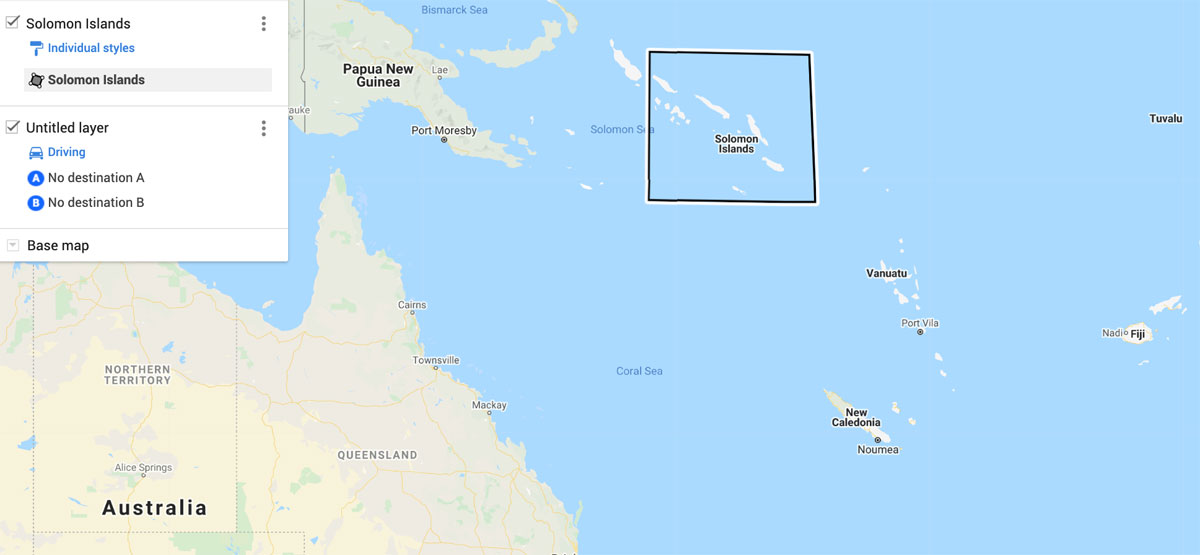
The landscape varies from rugged mountains (some with volcanic activity) to low-lying coral atolls.
We traveled for five days sailing around the New Georgia Islands (also called West New Georgia) of the Western Province (the main town is Munda) and two days in Guadalcanal Island (with the capital of Honiara).
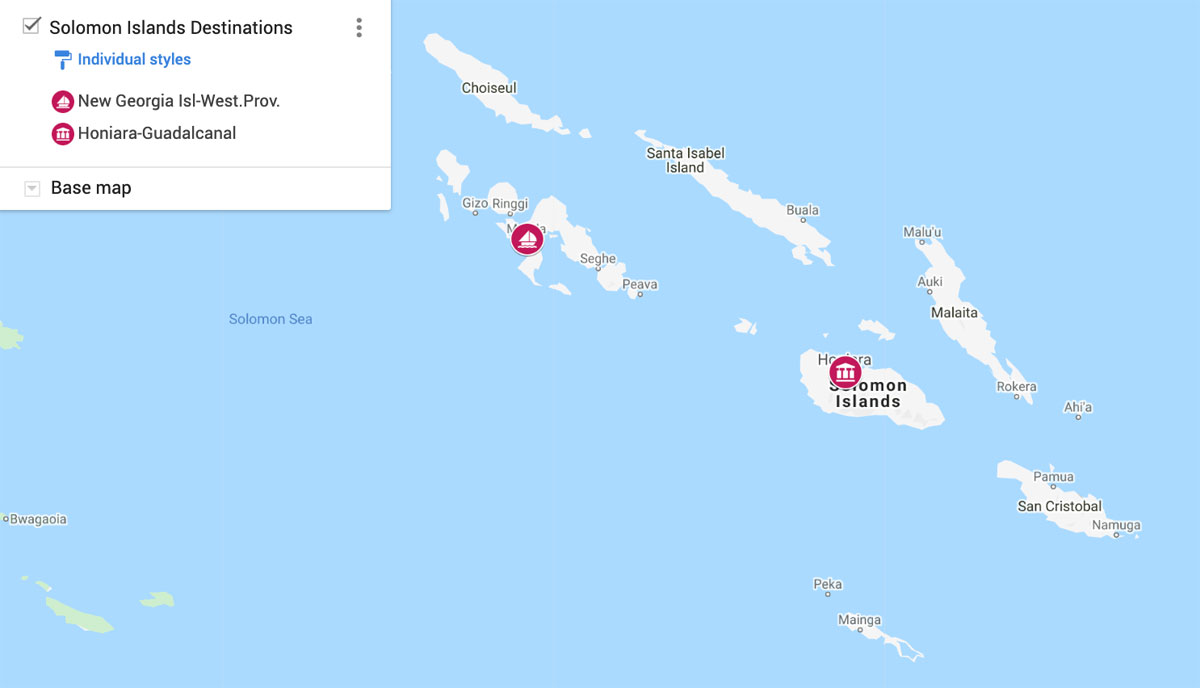
We flew a little over three hours on Solomon Airlines from Brisbane non-stop to Munda. From Munda, we also flew on Solomon Airlines about 45-minutes non-stop to Honiara. When we left the country, we flew Fiji Airways about three hours non-stop to Nada, Fiji.
Are the Solomon Islands Safe?
Most of the islands are safe places to travel. Life in the country, particularly the villages, revolves around the church, and religiosity is high. While not typically dangerous, it would be unusual to go to a small village without someone known to locals. In Honiara, we found we could walk anywhere without problems during the day. At night, we felt it was prudent to take taxis.
New Georgia Islands of the Western Province
Chemistry Catamaran
We sailed and stayed in the SV Chemistry catamaran for five days and nights. It’s owned and operated by Gavin, originally from the U.K., and now an Australian citizen. It’s a 60-foot boat with four cabins. Gavin pilots the boat, Luciana assists, and cooks, and Luna is the watchdog.
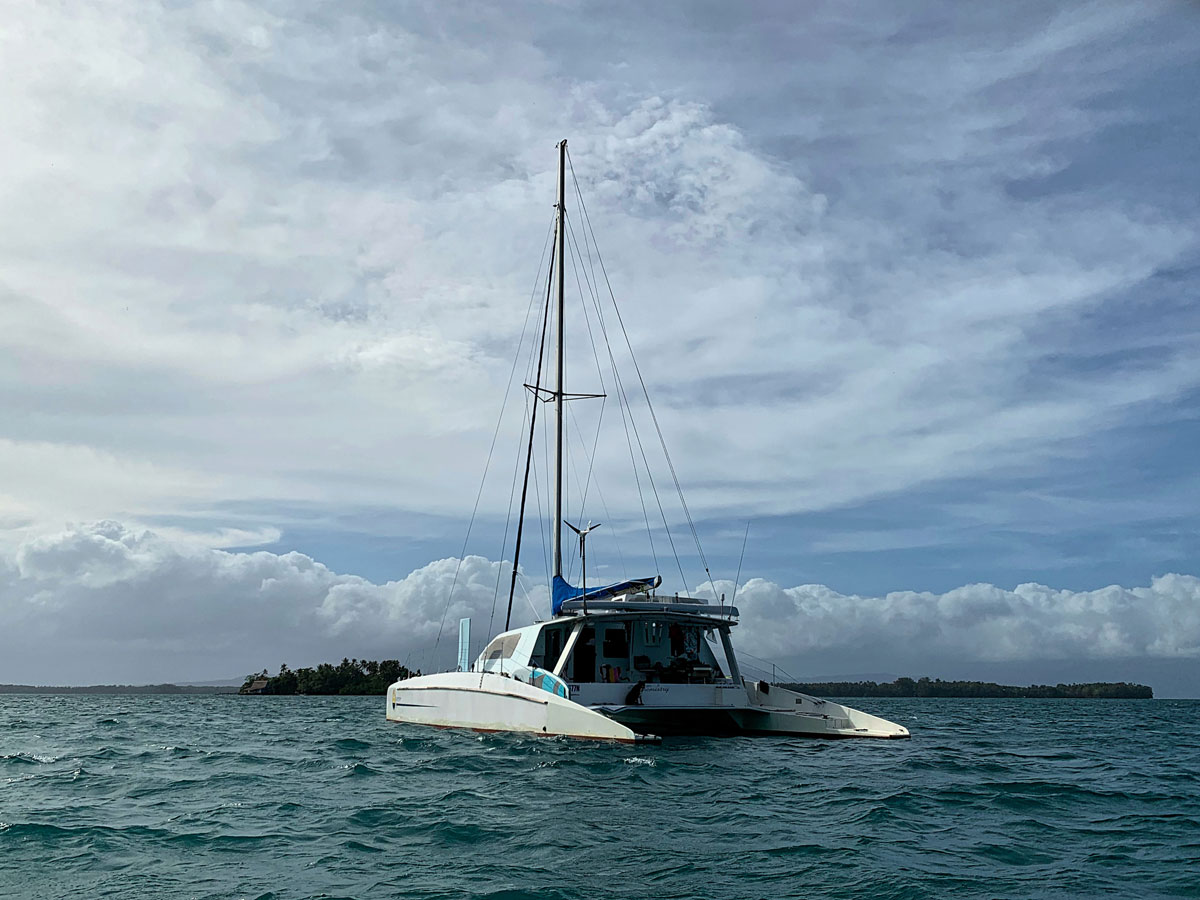
Our friends Caitlin and Peter were supposed to go with us, but Caitlin became sick last-minute in Australia, and they could not make it. We had arranged a trip with a focus on snorkeling, as that’s a passion of theirs. However, Khadija and I are more interested in visiting small villages and learning about the culture. If we had known we would be the only two guests, the itinerary would have been somewhat different.
On the map below are some of the places we sailed.
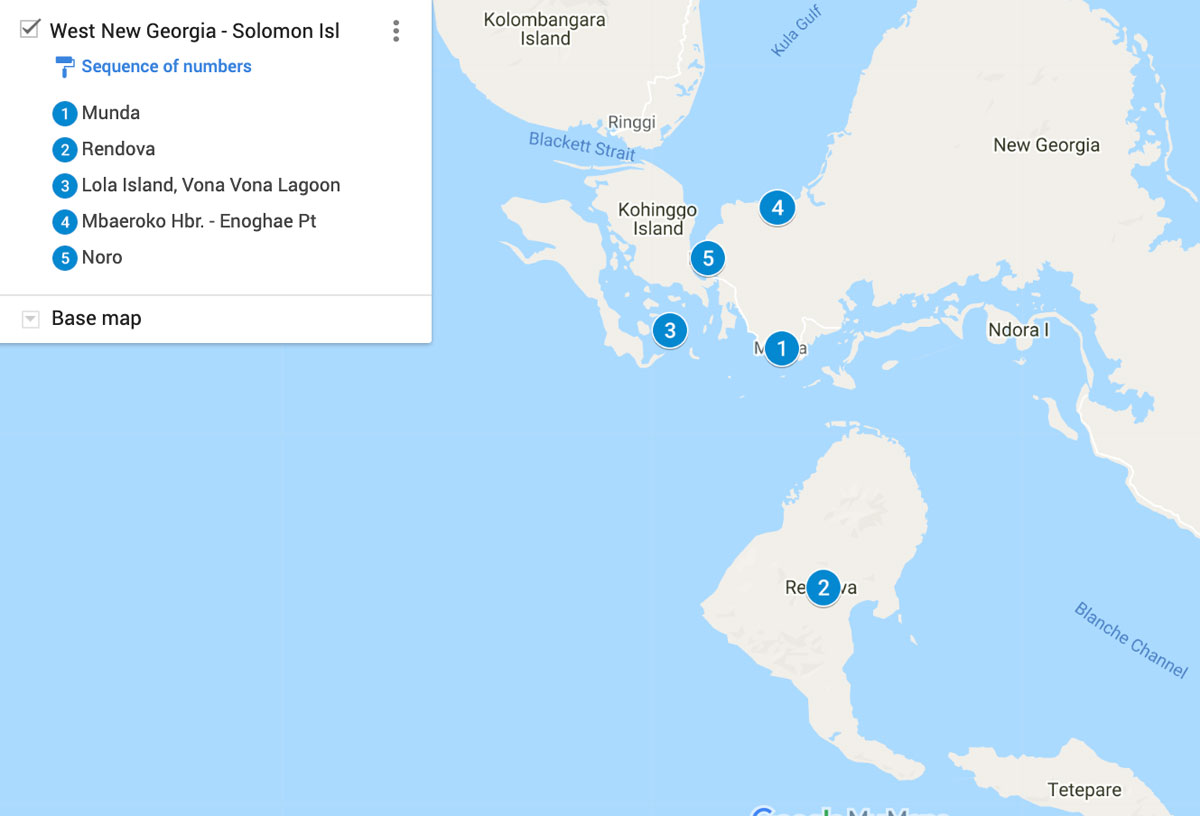
Munda
Munda is a collection of six villages on the southwest corner of the main island of New Georgia and has a population of around 3,000. It was once a coconut plantation, then became the site of the construction of a Japanese airstrip, which is currently the Munda Airport.
On our first night, we stayed at the Agnes Gateway Hotel on the shores of the Roviana Lagoon. It’s the only hotel there, although there are a few houses which have a few rooms to rent.
Munda is small. In fifteen minutes, we walked from the airport, by a couple of general stores run by recent immigrants from mainland China, past an outside food market to the hotel. After checking in, we walked around town and witnessed the local life, including women selling clams in the market…

children of all ages…
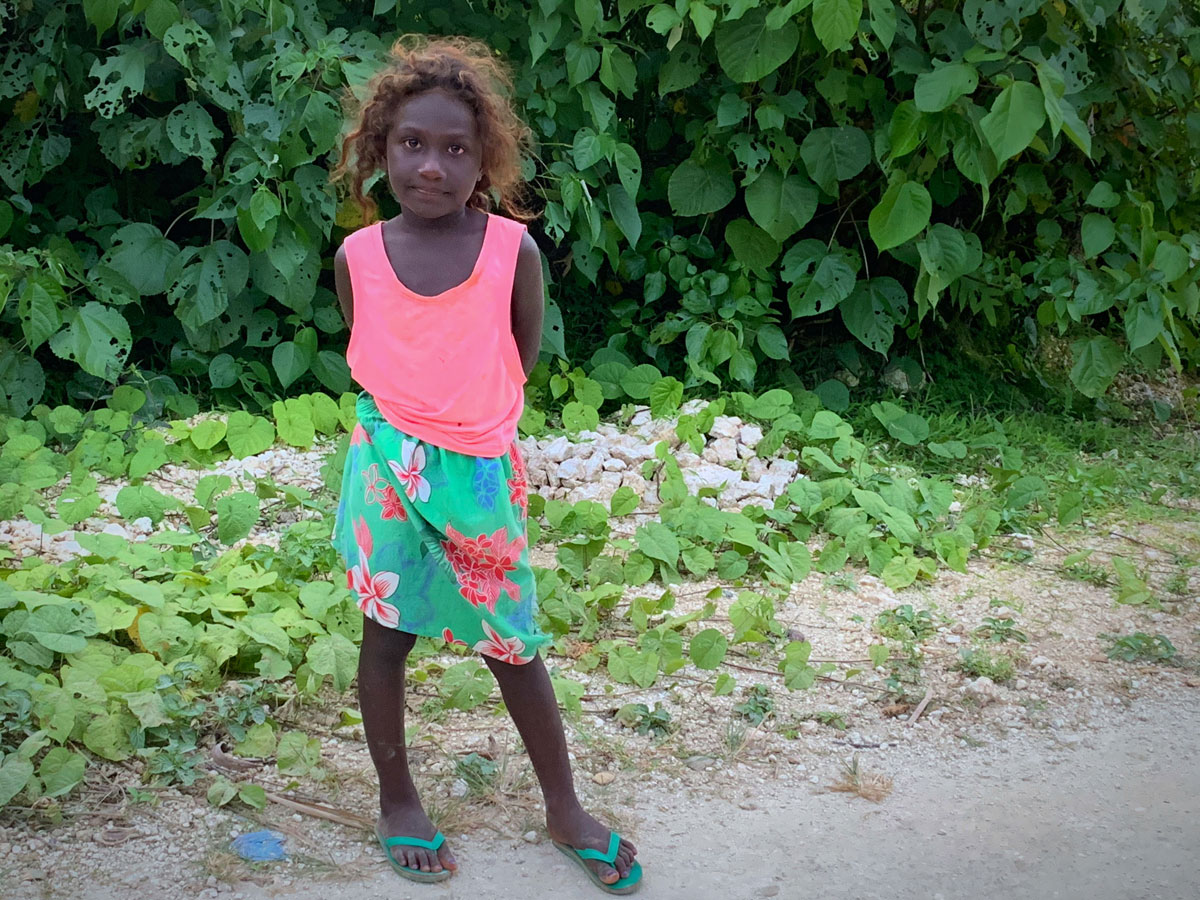
and a muralist at work.
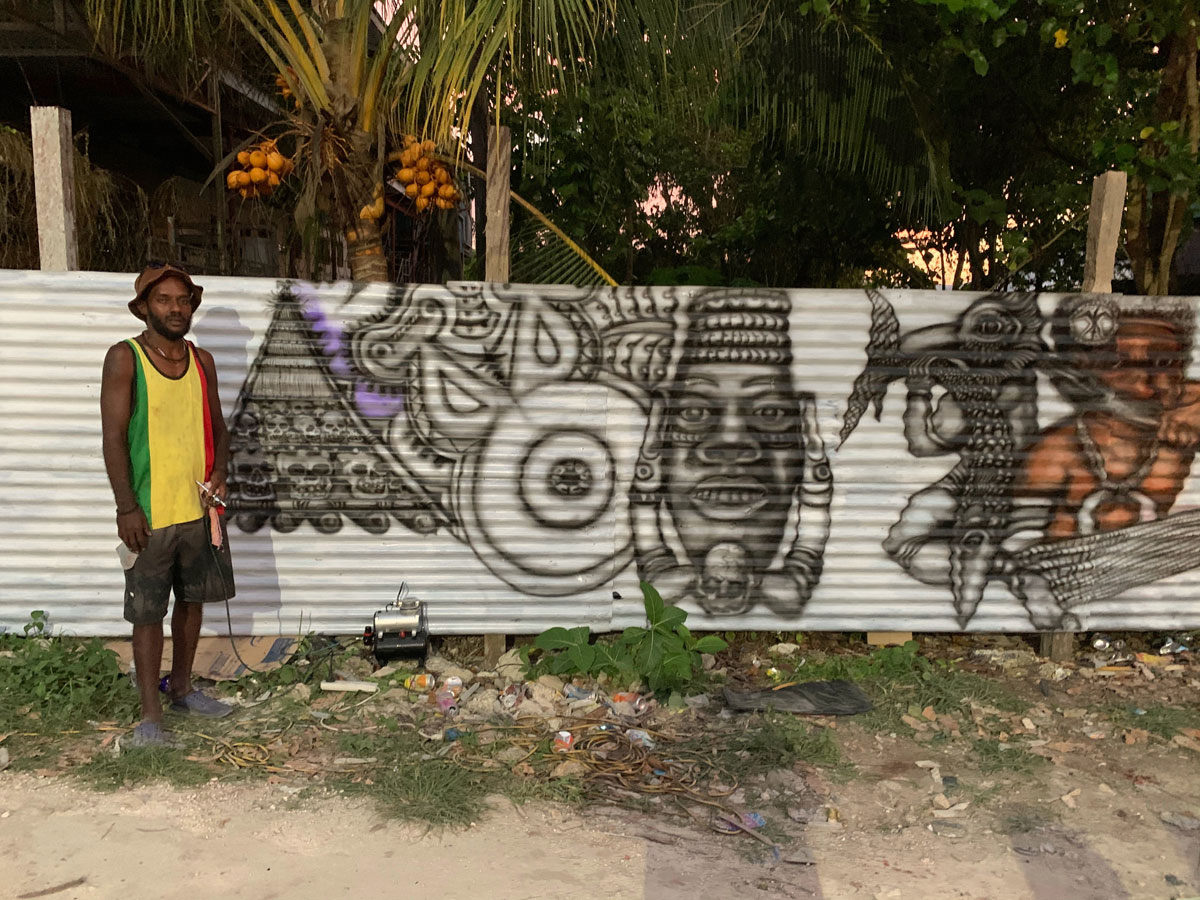
The Barney Paulsen’s Peter Joseph WWII Museum is the one must-see when in Munda. Barney has been on a mission to collect items left from World War II, including guns, knives, grenades, helmets, dog tags, eye-glasses, and Coca-Cola bottles.

The museum is named after Peter Joseph Palatini, whose dog tag was Barney’s first discovery.
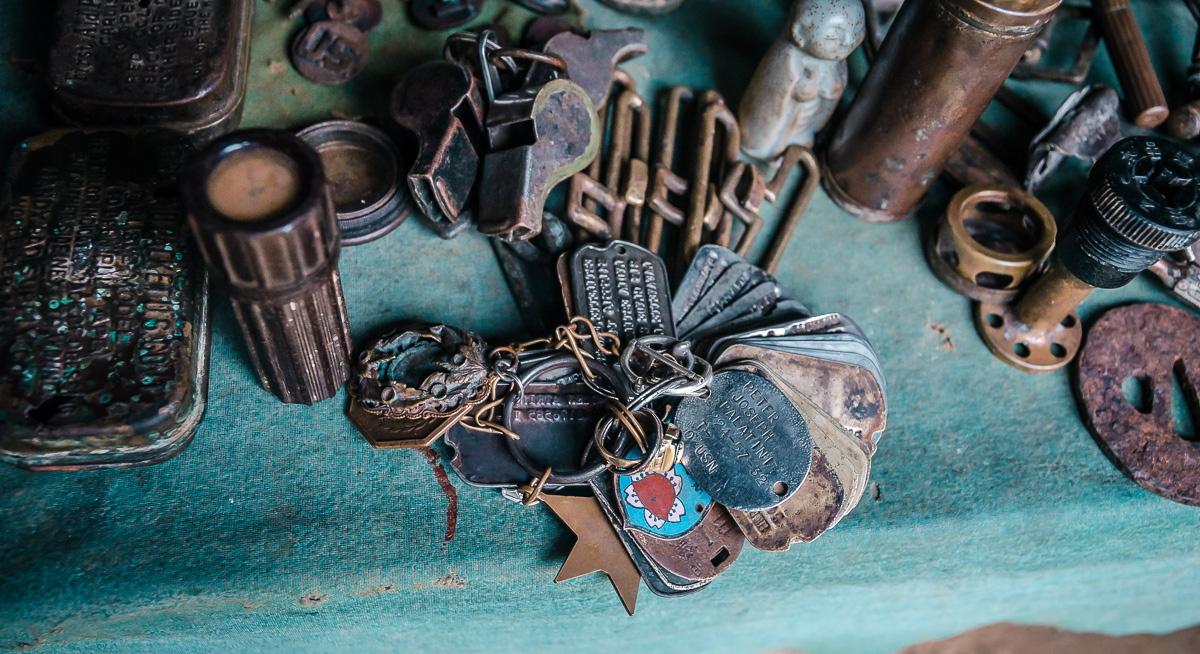
Barney has returned many dog tags to surviving families. The collection is a fifteen-minute taxi ride from the Agnes Gateway Hotel.
Rendova Island
The next morning we met Gavin on the dock, and he took us and our luggage to the catamaran in his dingy.
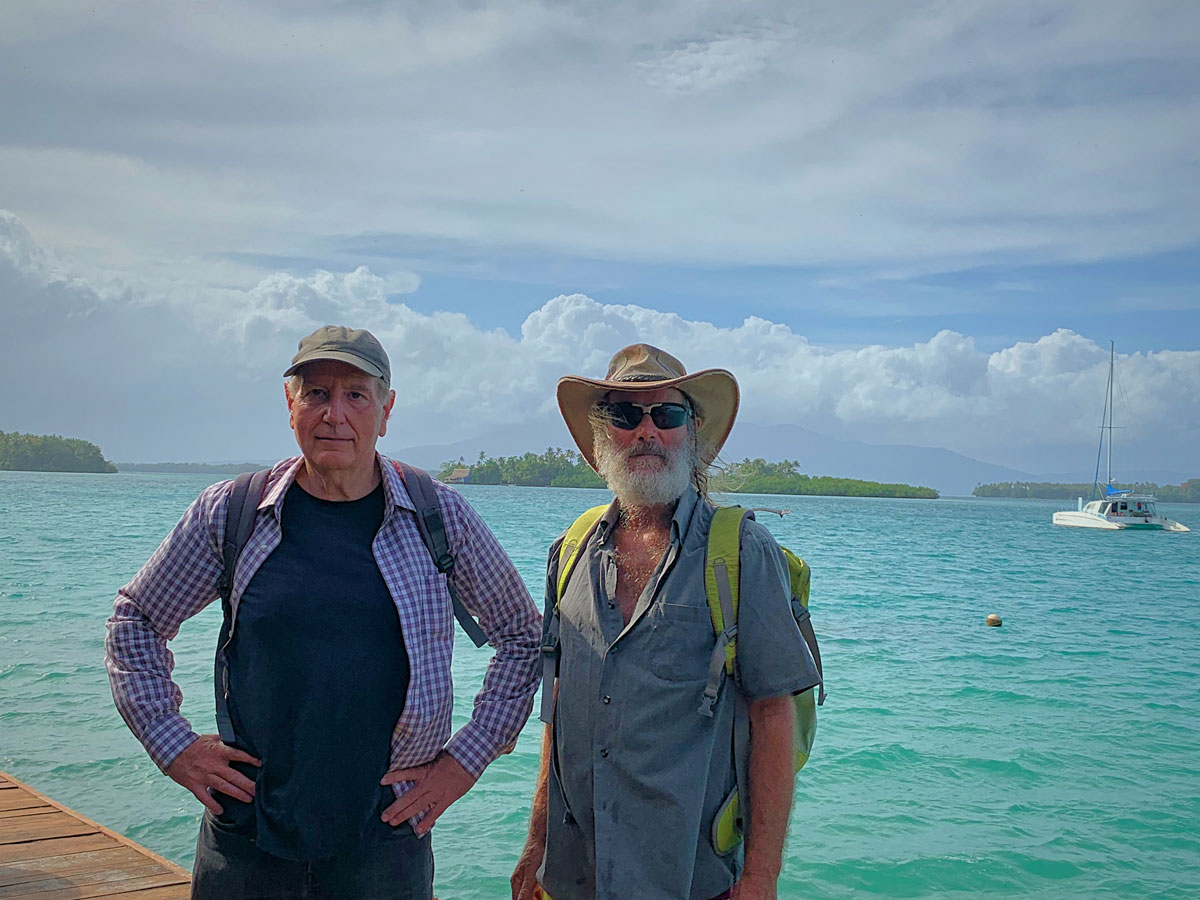
We sailed to Rendova Island. Since it was Sunday, we stopped at Eghalo Village to see if there was a church service. The village’s United Church (a Methodist’s offshoot) was active with children singing hymns.
Every village has a church and religion exerts a powerful influence on daily life. The country is about 75% Protestant, 20% Roman Catholic, and 5% other Christian.
While we didn’t see any memorial, Rendova is where the famous PT 109 incident happened. The Patrol Torpedo boat was commanded by then 25-year old Lieutenant John F. Kennedy, future President of the U.S. On a mission; they were spotted by a Japanese destroyer which rammed the PT 109 and cut it in half (painting from the John F Kennedy Library).
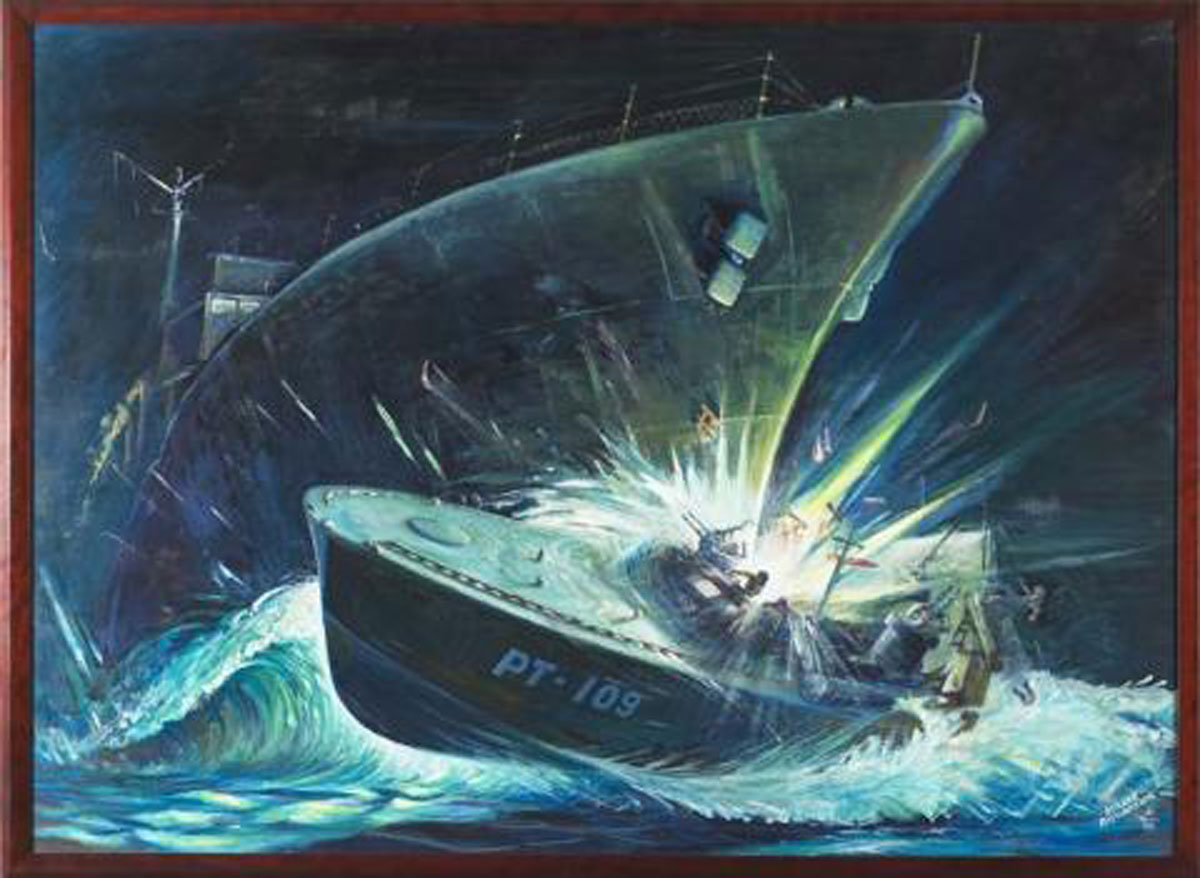
Kennedy, while injured, saved the men out of the water in the remaining floating half of the boat. It took almost a week before the Navy was able to rescue them. Tragically two of the thirteen crew died.
If you want to know more, read Robert Donovan’s book PT 109: John F. Kennedy in World War II or watch the movie PT 109, which was adapted from the book.
Gavin introduced us to Sago, who lived by the Eghalo Village. Sago took us to the remains of a B17 “Flying Fortress” bomber using a machete to cut through the forest.

Sago showed us drawings of the plane and identified the scattered parts. Later we bought a rosewood bowl from him, which was of exceptional quality.
While anchored by Rendova, we negotiated with locals coming to the boat selling their wares.

In the morning, we would see children paddling their canoes to school.

Vonavona Lagoon
After being anchored by Rendova Island, we sailed to Vonavona Lagoon. Our first stop was the minuscule Skull Island, where Luna swam there before us.
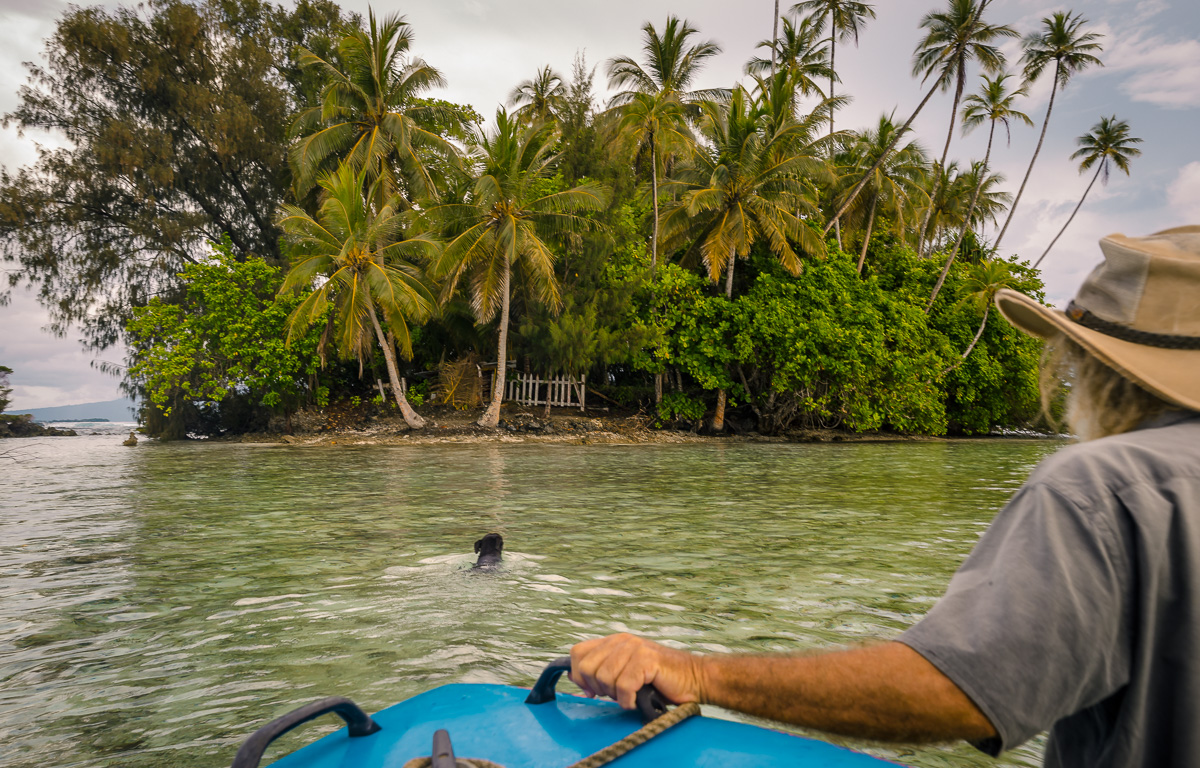
Eerily, there were stacks of skulls of local warriors and chiefs, ceremoniously placed under wood structures atop burial mounds. The remains are 100 to 300 years old.
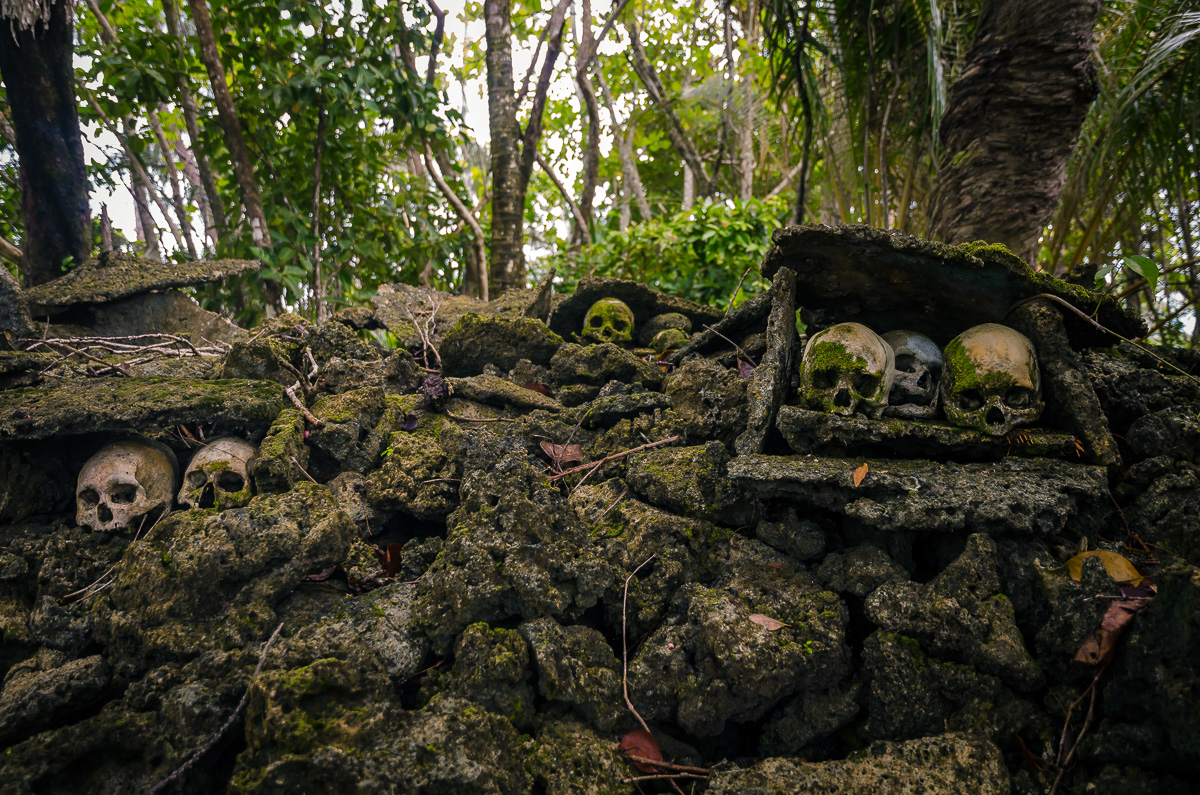
The Methodist Church and the British, who ruled most of the Solomon Islands starting in 1893, stopped cannibalism and slavery by WWI. Part of that effort was curtailing head-hunting in the New Georgia Islands. This barbaric practice was based on the belief you can acquire a person’s power by capturing the skull. Raiding parties returned with male heads and female captives, some were eaten, and others enslaved.
On Lola Island, we stopped for a drink at the Zipolo Habu Resort, where the 60s and 70s blues-rock was playing on the sound system. We met owner, Joe Entrikin, originally from Seattle, and married to a Solomon Islander. He had many stories, including that his only customers during the ethnic strife in the early 2000s, were the refugees fleeing Guadalcanal. We walked through the adjacent forest and saw finger-length crabs scampering on the ground.
In the muddy water by the beach, we saw schools of small fish, sea snakes, and a 2m (6.5 ft) reef shark.
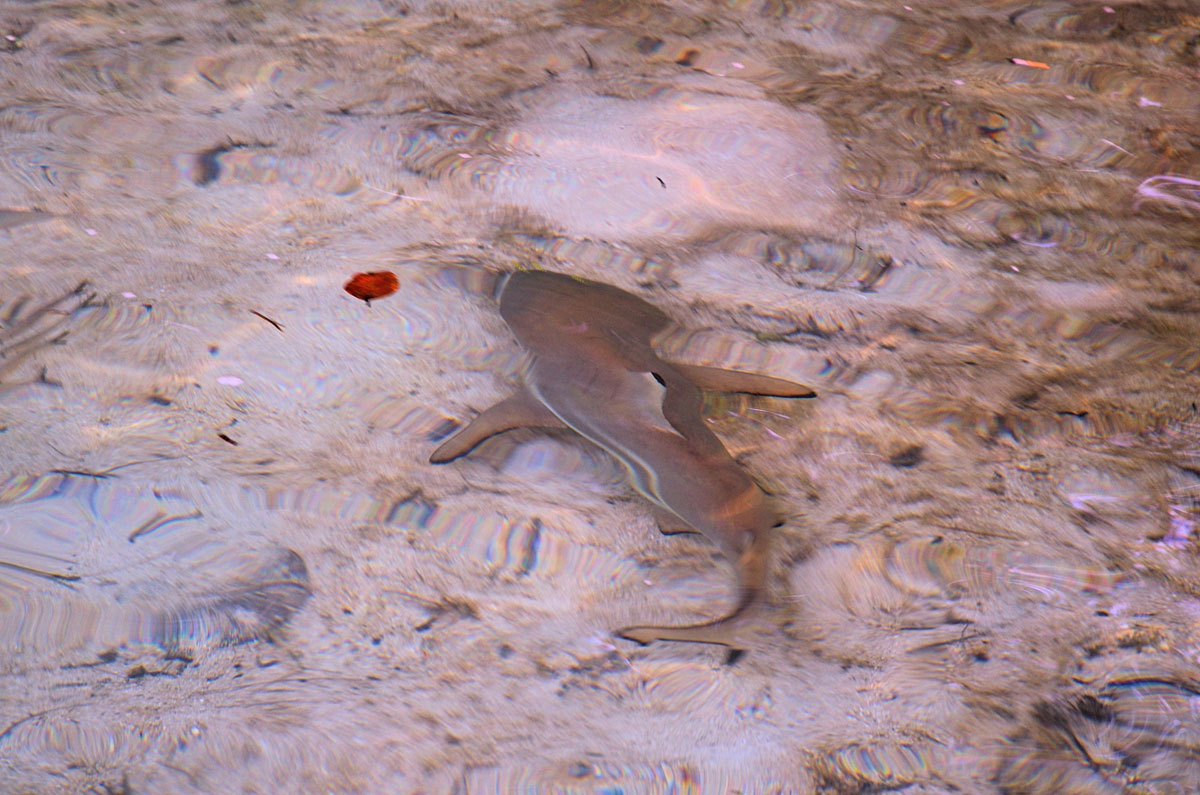
In Boboe Village on Kohingo Island, Gavin arranged for locals to show us their locally made goods, mostly bowls. Afterward, we walked around and saw children playing…

entered a classroom…

talked with the boys outside the classroom…
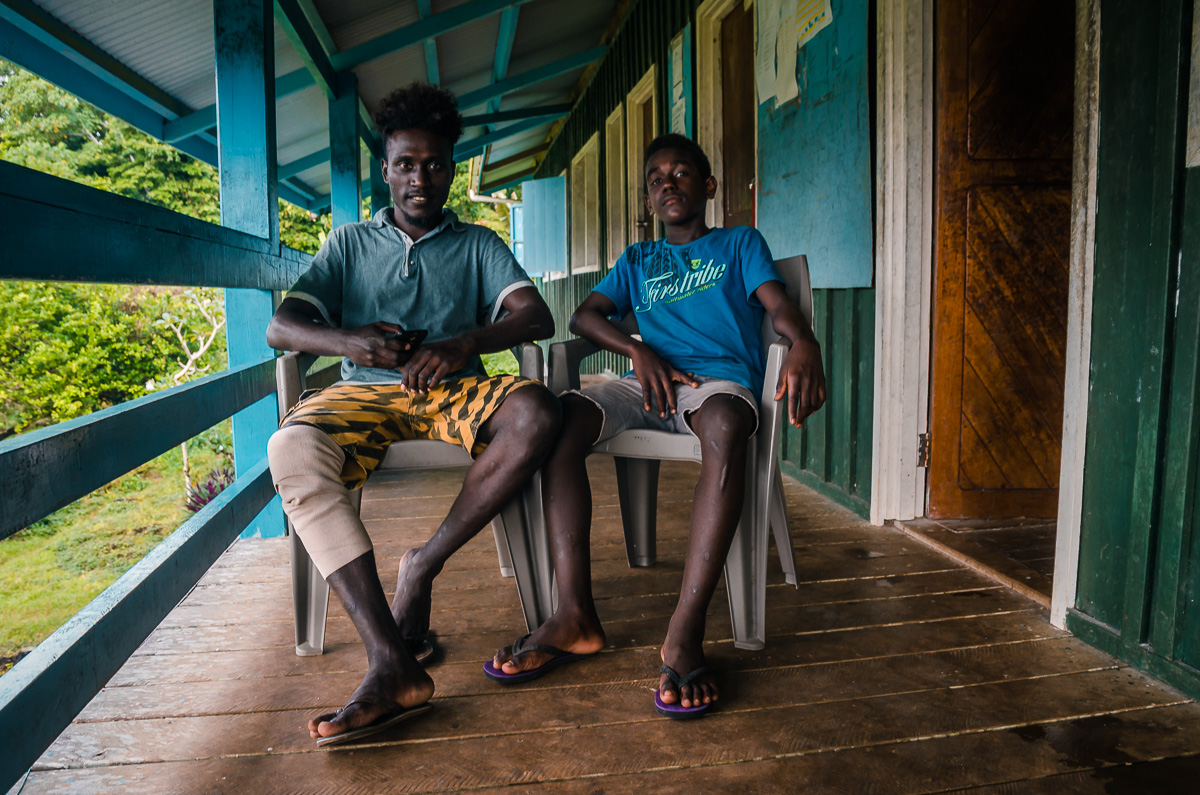
and tasted food from a bake sale to raise money for the school (this is an example of many activities that are common throughout the world).
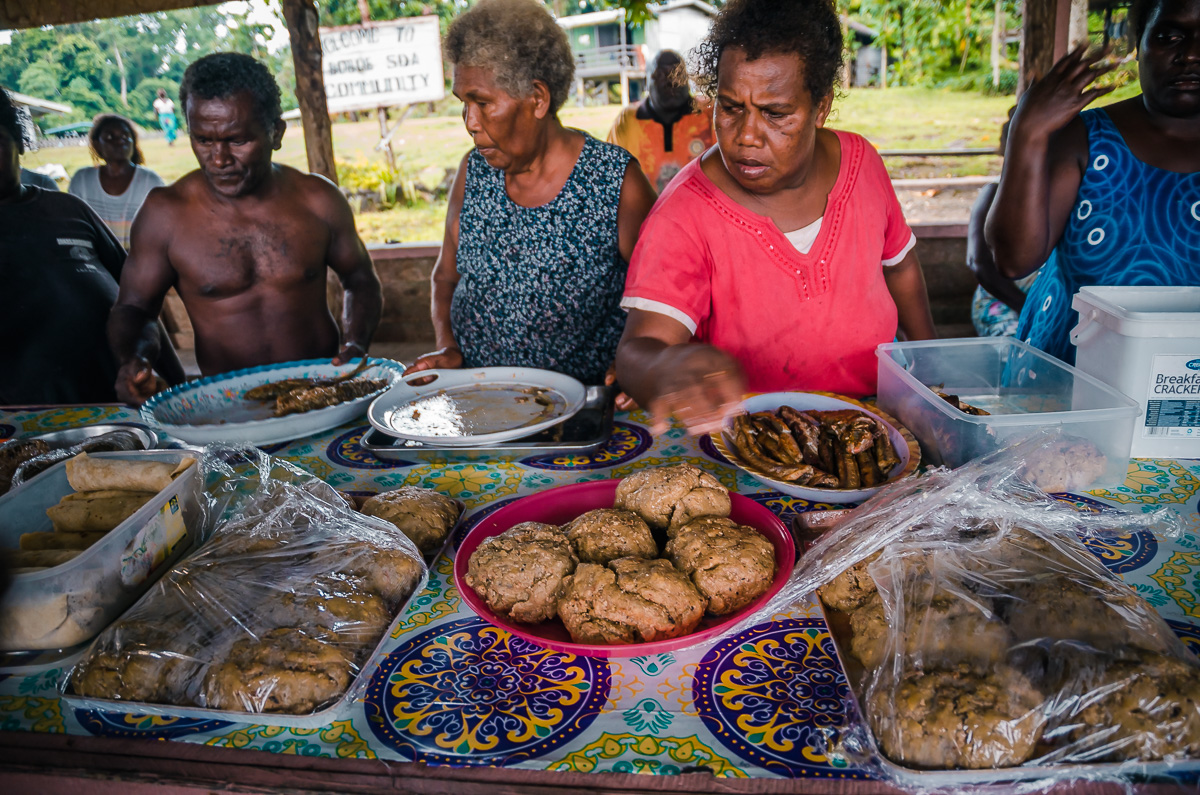
After each busy day of visiting islands and snorkeling, we kicked back and watched the sunset stretching across the horizon from the back of the catamaran.

Enoghae Point with Japanese Artillery Guns
From the Vonavona Lagoon, we sailed to Enoghae Point, located on the island of New Georgia. It’s heavily forested with few inhabitants. The highlight was inspecting the rusting, artillery guns left by the Japanese.
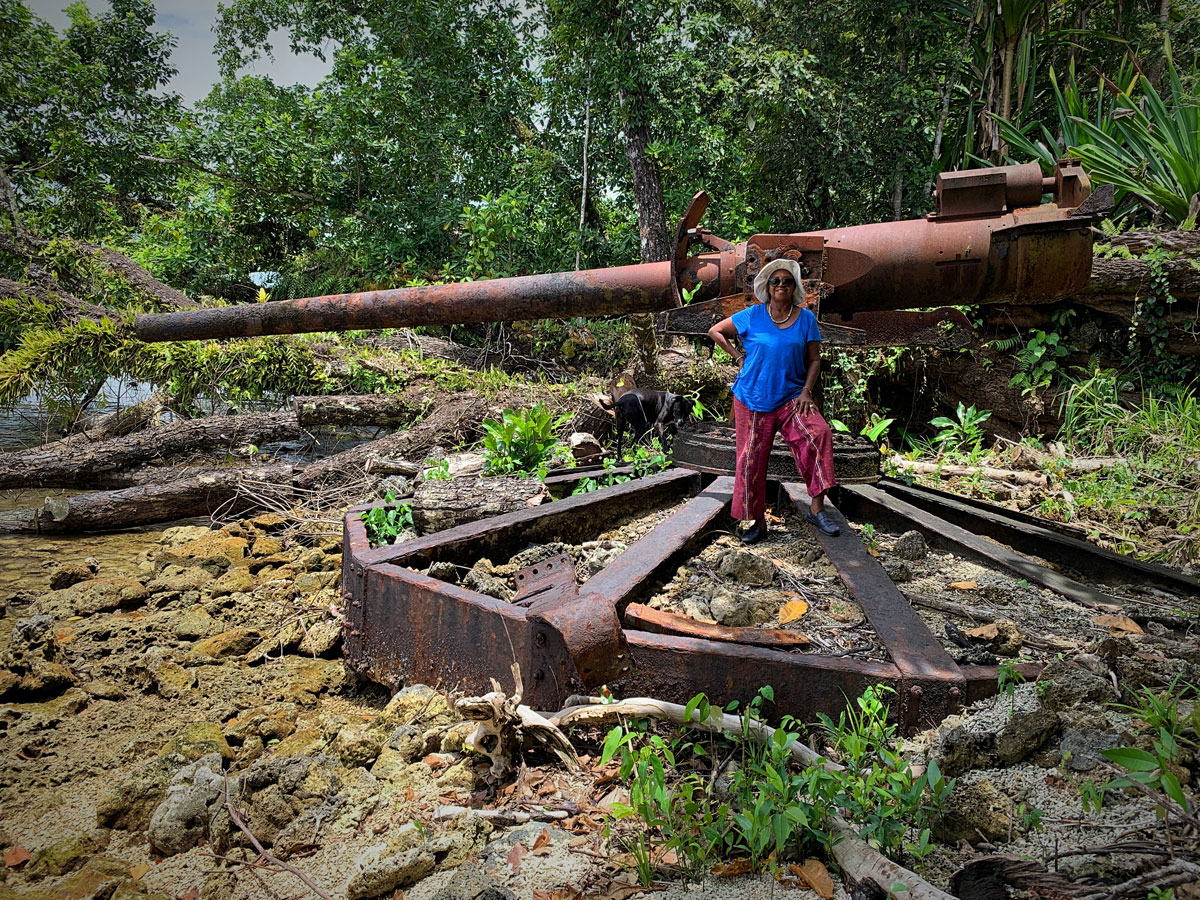
From here, we sailed through the Hathorn Sound, passed the town of Noro known for its substantial fish-cannery operations, through the Diamond Narrows, and returned to Munda. During this long ride, I had one of many discussions with Luciana and how she left Brazil after raising a family and started working on boats in the Pacific.
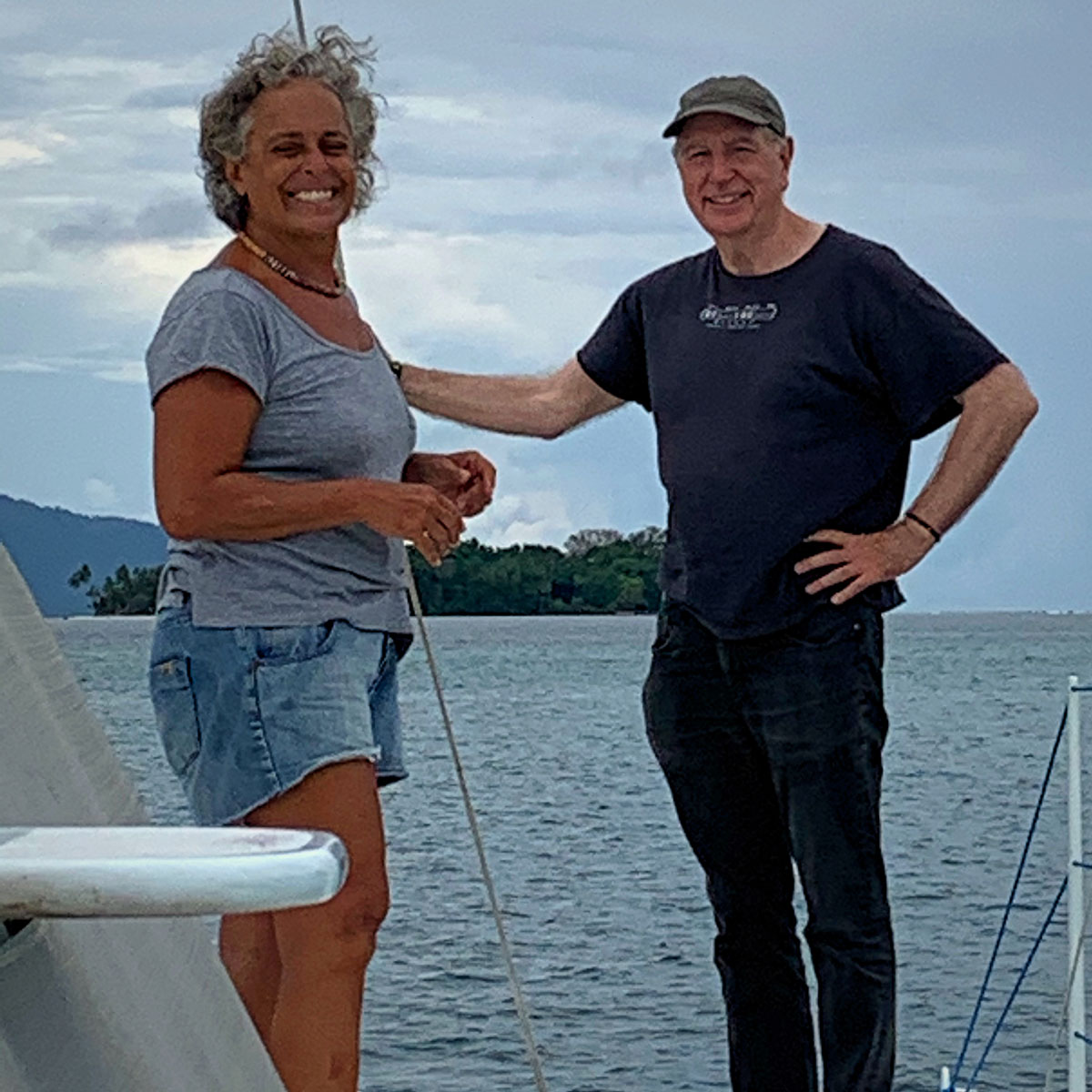
Guadalcanal Island and Honiara
Honiara is the only true city in the Solomon Islands and with most development on the coast. It is on the island of Guadalcanal, which will be forever famous for the Battle of Guadalcanal during WWII, a series of naval and aerial engagements between the Allied Troops (mostly Americans) and the Japanese Imperial Forces from August 1942 to February 1943. After the Pearl Harbor attack in December 1941, the Japanese landed on Guadalcanal in June 1942 to begin the construction of an airfield. If completed, this airfield could threaten the supply routes and communication lines between the U.S and Australia. When the Americans invaded and seized the airfield, the Japanese attempted many times to reclaim it, which resulted in six naval battles, three major land battles, and constant aerial battles. Here is a picture in the public domain from Wikipedia.
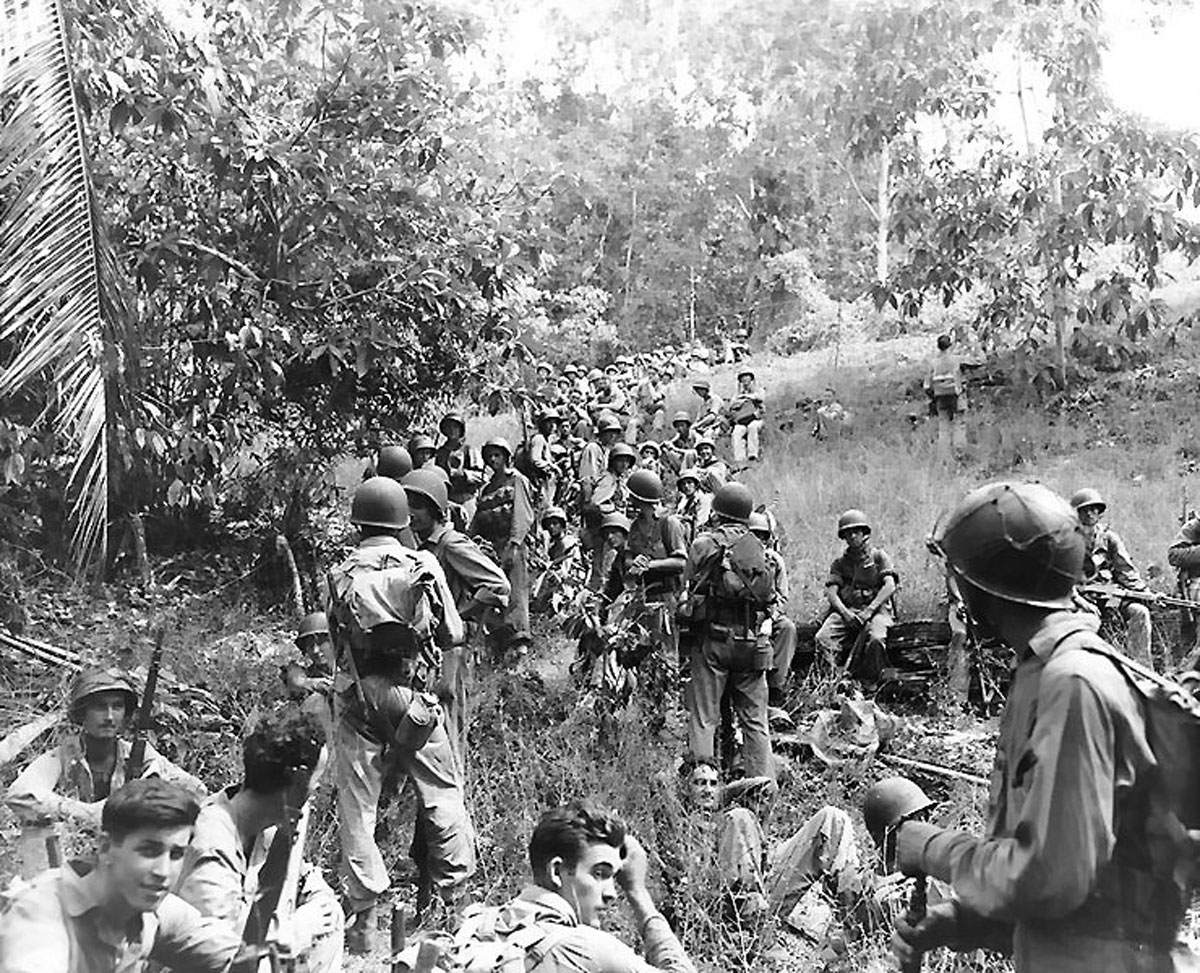
After six-months of ferocious fighting, the Japanese lost over 30,000 soldiers, 24 warships, and were forced to evacuate. The Guadalcanal campaign was a major turning point for the Allied forces, and Japan then transitioned from offensive to defensive military action.
We had only two days, and the following is a map, including the sites we visited.
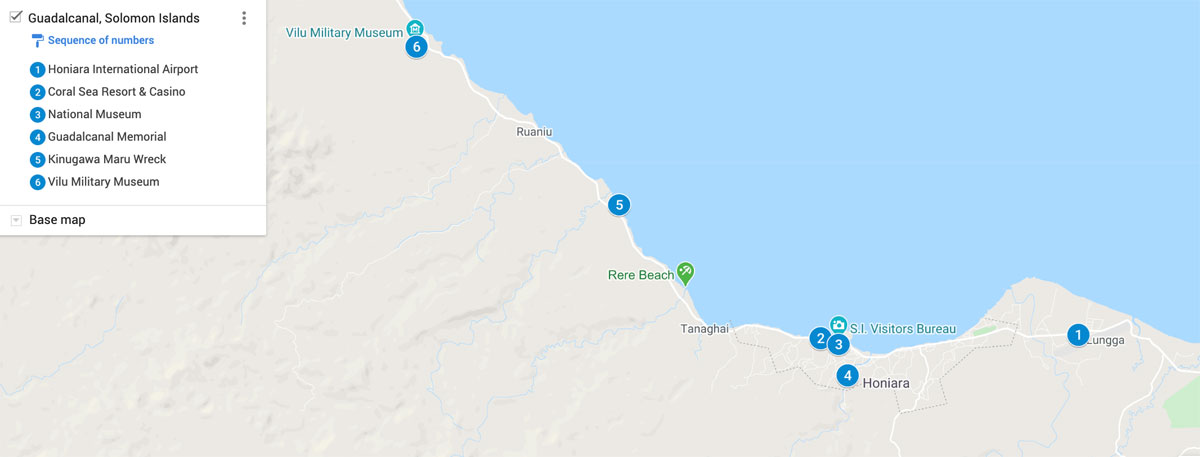
We used Travel Solomons Ltd for a half-day tour of the Western battlefield where most of the relics are. The Eastern battlefield tour is more an explanation of the fighting where it took place. Our excellent guide was Jeffrey Tafolehe.
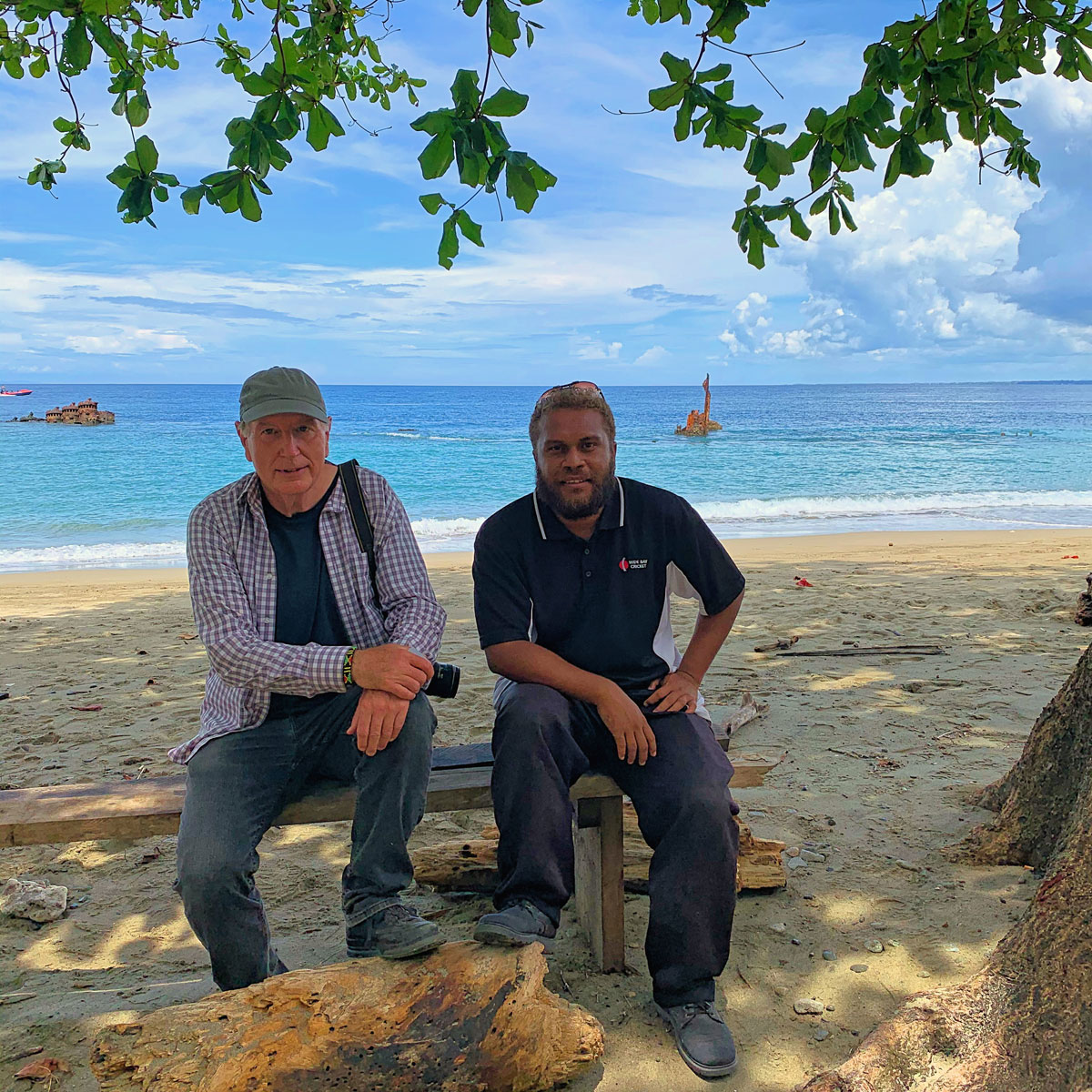
The Guadalcanal American Memorial was built as a tribute to the Allied soldiers, who lost their lives during the Guadalcanal Campaign. It is situated on a high hill with a view of the coast and surrounding area where considerable fighting took place.
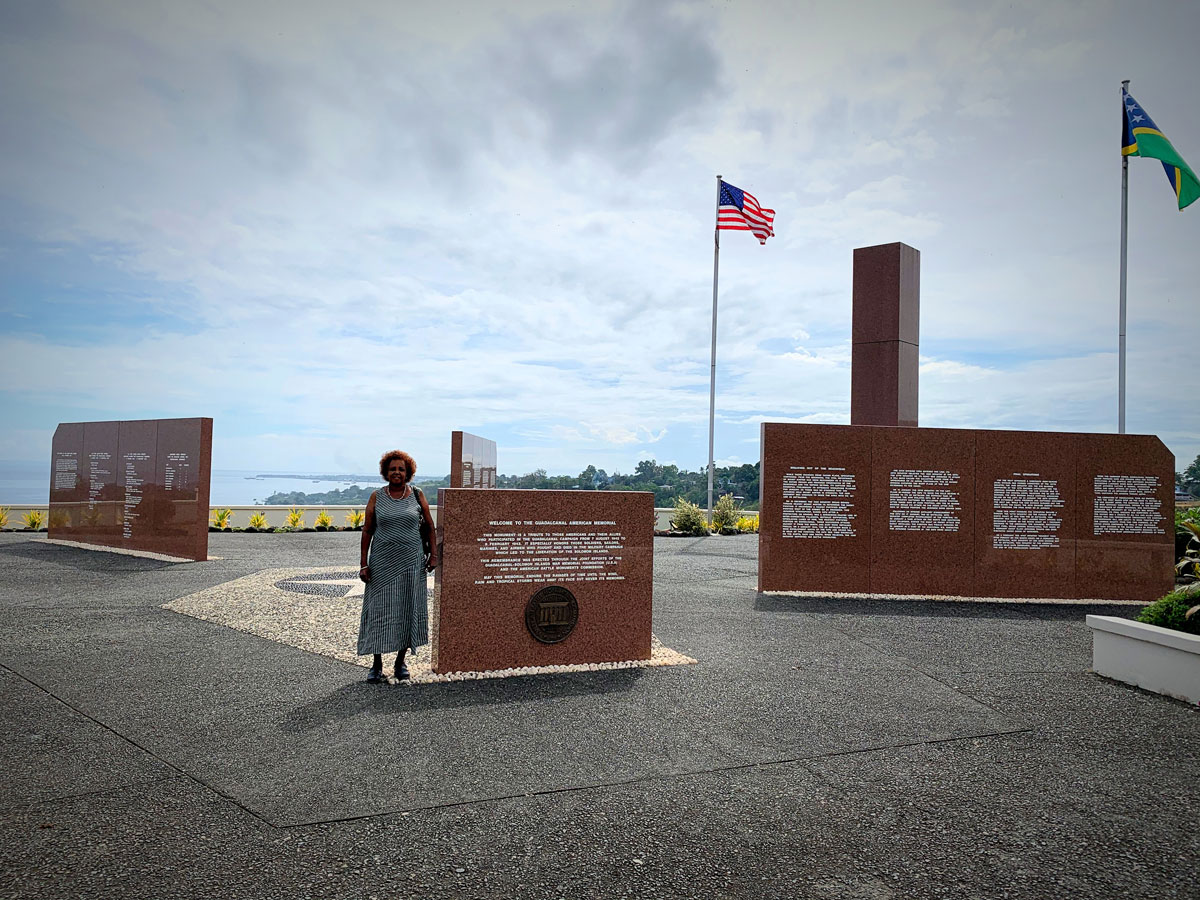
The memorial inscription reads: “This memorial has been erected by the United States of America in humble tribute to its sons and its allies who paid the ultimate sacrifice for the liberation of the Solomon Islands 1942–1943.”
An hour drive west of Honiara is a family-owned, open-air museum called the Vilu War Museum with an amazing collection of battle relics of American, Japanese, New Zealand, and Australian origins.

Bonegi or Mboheni Beach is a haven for diving and snorkeling enthusiasts. Divers have named the shipwrecks off the beach Bonegi 1 and Bonegi 2, but the original names are Hirokawa Maru and Kinugawa Maru, respectively. These are two large Japanese freighters that sank on November 13, 1942. Only the tips are above water, as you can see in this photo of Bonegi 1.
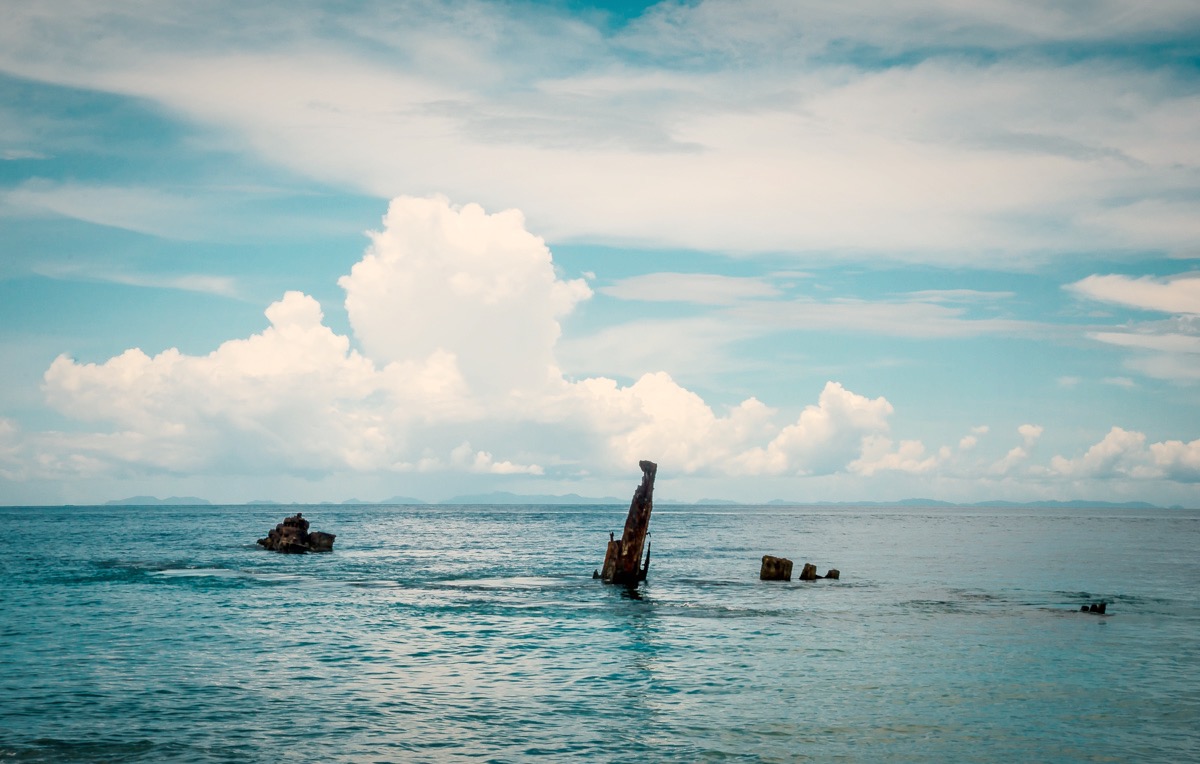
Both have become home to diverse marine life.
The Jacob Vouza Memorial honors a Guadalcanal local who served for the American Allied forces during WWII. He first met marines after rescuing an American navigator and guiding him towards an American base. He then volunteered as a scout for the Americans but was later captured by the Japanese during one of his missions. Despite the torture he endured, he refused to provide information to his captors. He returned to American lines after freeing himself and provided the marines with valuable information. He resumed his scout service and became active during the Guadalcanal Campaign.
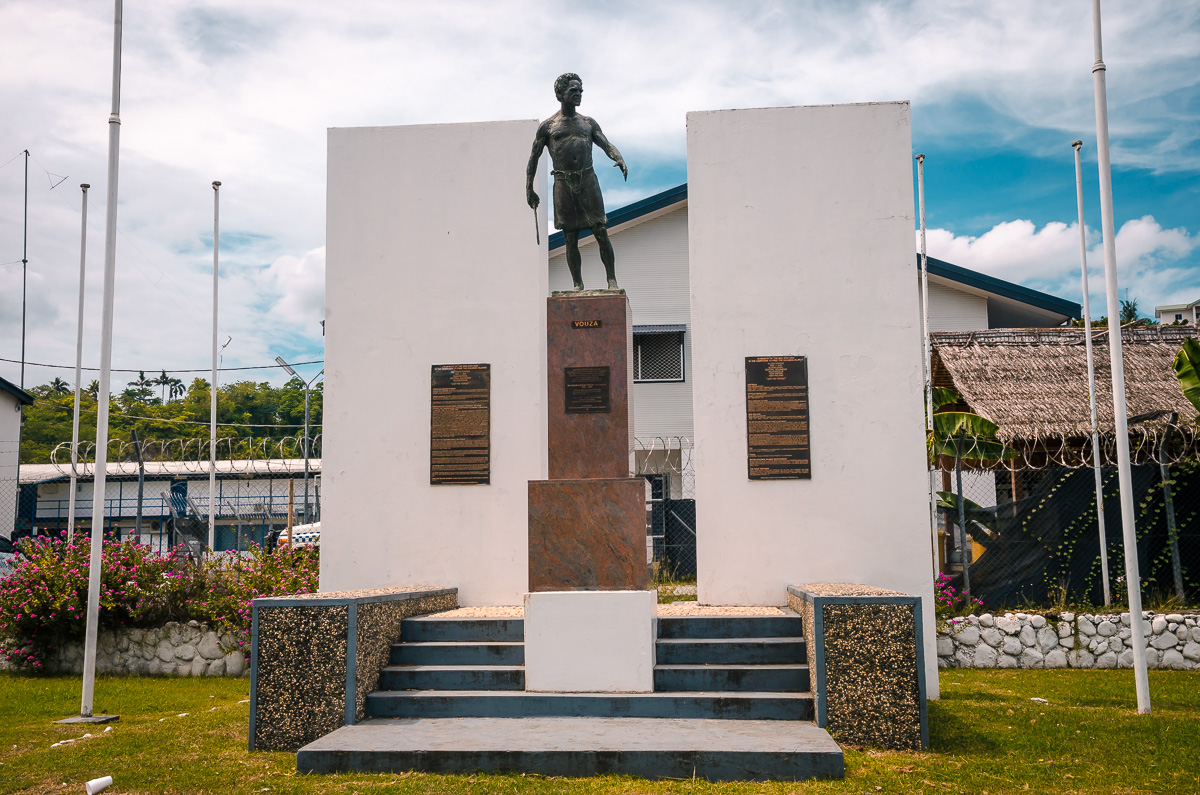
He was awarded a Silver Star (second highest in the U.S. military) and Knight Commander of the Most Excellent Order of the British Empire, which came with the title “Sir.”
We stayed overnight in the Coral Sea Resort and Casino in the center of Honiara and only 11 km (7 mi) from the Honiara International Airport. The rooms were clean and modern; the service was excellent. From there we walked or took the bus to nearby cafes.
Final Thoughts on the Solomon Islands
A completely unanticipated unique experience of the trip was being with Luna, the effective watchdog, and excellent swimmer.
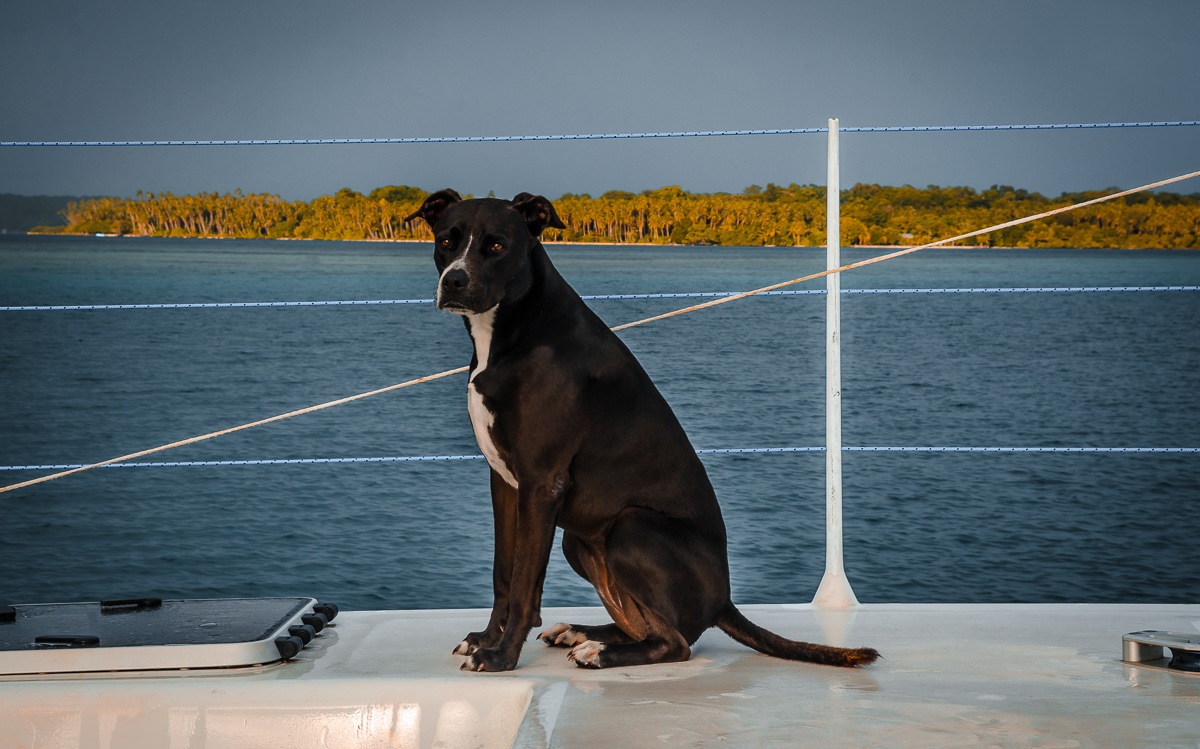
She looked almost identical to our dog Georgia, which our family lovingly had for eight years.
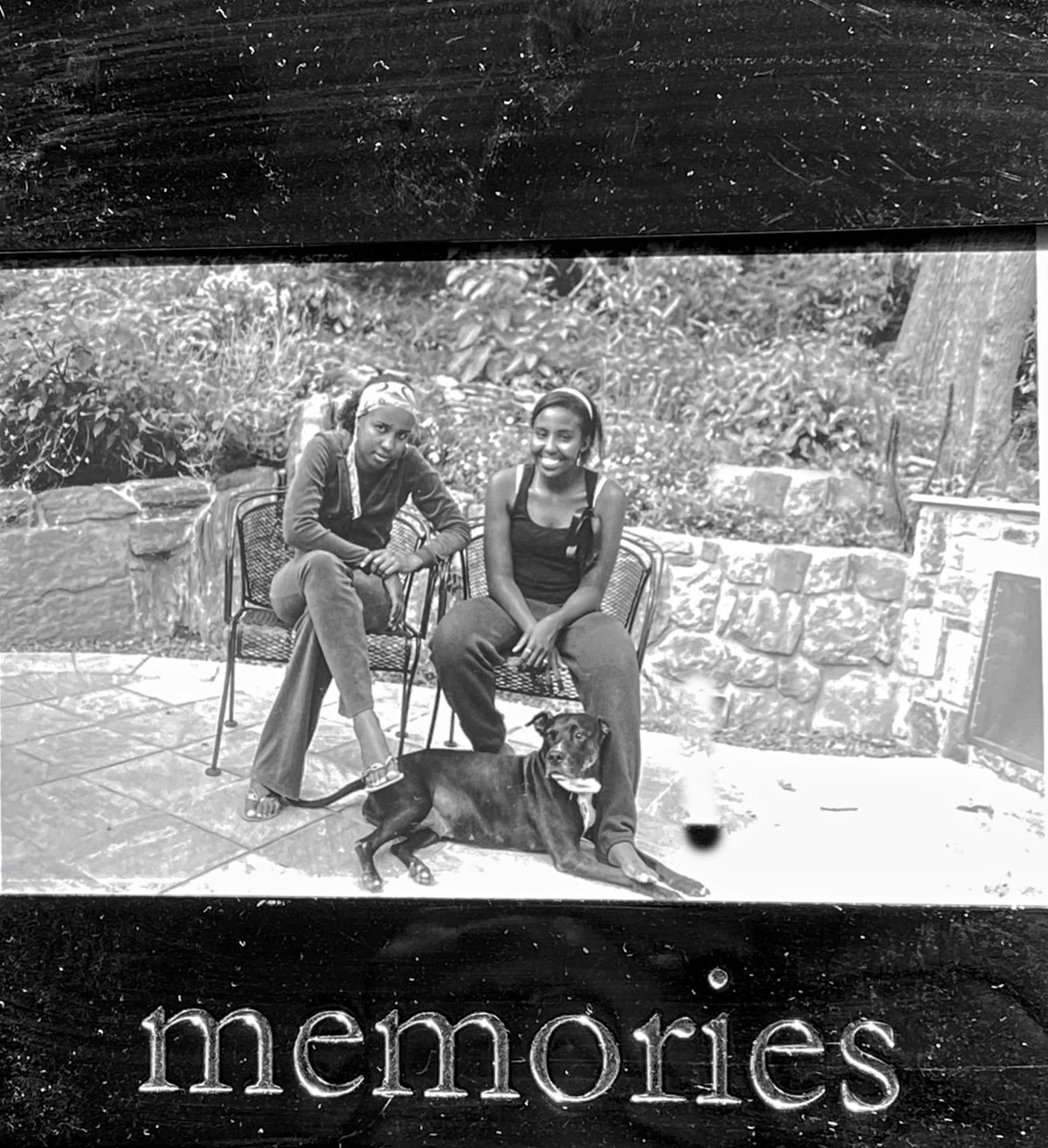
Luna even had the same characteristics as Georgia, such as not wanting to be alone in a room and being protective of us. Watching Luna in the prime of her life allowed Khadija and I to recount our time with Georgia fondly.

